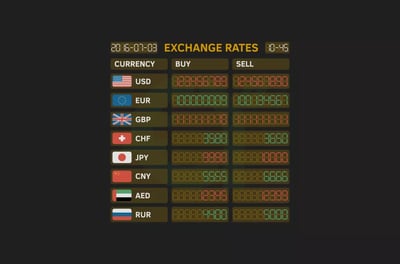Pros and Cons of Trading Major FOREX Pairs
Early in my trading career, I set out to understand the basics. In this case, grasping the meaning of “major” currency pairs in FOREX trading was no different. Indeed, a good starting point when learning how to trade FOREX online is to better understand currency pairs in general. The good news is that the basics are quite straightforward, and the way in which pairs are quoted works the same across all currencies, from those most popular and regularly traded to the more exotic and so-called “minor” FOREX pairs.
Major currency pairs like EUR/USD and USD/JPY offer tight spreads and deep liquidity that lower trading costs
High trading volume in majors creates consistent price action and makes them easier to analyze and trade
Reliable data and forecasts are widely available for majors, making them more transparent than exotic pairs
Leverage is generally safer with majors because they’re backed by stable economies and less prone to wild swings
Despite their stability, major pairs can still experience sharp volatility during unexpected market shocks
Majors rarely offer the big price swings seen in exotics, so profit margins can be limited for aggressive traders
Competition and efficiency in major pairs mean fewer opportunities to exploit price inefficiencies
While major pairs are lower risk, you still need a strategy and risk management to avoid losses

Introduction to Currency Pairs
I learned that, by way of definition, the most popular traded currency pairs are known as the majors. However, before we look at what constitutes the major FOREX pairs, we need to discuss what a currency pair actually is. With FOREX trading, you are speculating on the value of one currency relative to the value of another. When two currencies are grouped and valued against each other, the resulting exchange rate is known as a currency pair.
This relative value is expressed as the price of a certain number of units of the first currency in relation to the second currency. I will now present you with an example that would help you learn how to read currency pairs. If you were to look at live FOREX prices on a trading platform, like MT4 or MT5, you would see a wide variety of FOREX currency pairs listed. Every currency has a three-letter International Organization for Standardization (ISO) code, which is fairly straightforward. For example, the GBP denotes the British pound while USD refers to the US dollar.
Let us suppose you think the euro will strengthen and the US dollar will weaken; you will likely want to sell the US dollar and buy the euro. The currency pair you are therefore interested in is the euro-US dollar (EURUSD). Remember: a currency pair expresses how much one currency is worth relative to another currency, so the price quoted for the currency pair is the number of dollars per euro. If you are right and the euro strengthens, one euro will be worth more US dollars. In other words, the exchange rate will have gone up. So, if the EURUSD price is 1.5, it simply means you need $1.5 to buy one euro. If the price rises to $1.8, it indicates that the euro has appreciated against the US dollar, and you now need an additional $0.3 to buy one euro.
When working in the opposite direction and you are looking to use euros to buy dollars, follow the following calculation:
1/1.5= 0.66
So, at the above rate, you would need €0.66 to purchase a single dollar.
After a price change to $1.8, your new cost for a dollar using euros will be
1/1.8= 0.55
You can see that when the euro appreciated, it cost us about $0.11 fewer euros to acquire a US dollar than before.
Now that I've explained to you how to read a major currency pair as you would any FOREX pair, a good way to start trading FOREX is to start with something you know well. For instance, if you have close insight into a particular economy, you may naturally feel inclined to trade its currency. This could mean that you trade the currency of the country in which you live. Even if your home currency is not one of the majors outlined below, by knowing the economy well, you can make better use of the greater availability of economic news, as well as by supplementing it with FOREX analytics and technical analysis like Japanese candlesticks, moving averages, and chart patterns.
What are the Major Pairs Today?
I discovered that major currency pairs are made up of currencies from the world’s so-called “superpower” economies. Traditionally, these have been the major currency pairs:
However, opinions have varied over time and led to the expansion of the major currency pairs list to also include:
8. EUR/GBP
9. EUR/CHF
10. GBP/JPY
It is noteworthy that one of the key aspects of the lists of major currency pairs is that they often have the US dollar on one side. Furthermore, these are the currencies that account for most of the volume in the FOREX market, which is estimated at $7 trillion a day. When you check these currency pairs on your brokers' platforms, you will notice that they typically have the smallest spreads and are also the most stable. They also have the most liquidity because they are so widely traded. Most amateur traders, and even some experienced investors, prefer taking positions in major currency pairs over the remainder of the FOREX Market. We do not recommend trading exclusively in the majors; diversification is important, and a sound risk management strategy requires a well-balanced approach.
Why Traders Trade the Major Pairs
In my opinion, here are some reasons why the major pairs get all the attention in the FOREX world:
Cost of Trading: Like any business venture and/or commercial transaction, you want to keep your costs as low as possible. Luckily, FOREX major pairs offer you a chance to make trades in the FOREX market at a comparatively low cost. Although spreads can vary by broker, you will likely find that majors offer the lowest spreads across all trading platforms. Even though the pips are tighter, you can make more money by using leverage. To learn more about pips in trading, read our article here.
This is why most FOREX traders with limited capital prefer to invest in majors. Some well-capitalized investors do so, too, to minimize their risks while maximizing their returns.
Stability and Prediction: In all likelihood, you want to increase your chances of success by trading assets that are more predictable and fundamentally stable. Trading in minor FOREX pairs like USD/MXN and EUR/TRY exposes your funds to high volatility and price instability that can quickly wipe out your trading account and life savings. In short, majors are more stable and easier to predict.
Safety: Building on the last point, the stability of major pairs makes them a haven for investors looking to put their money into low-risk FOREX pairs. First, they are backed by strong economies that are less easily swayed by secondary events like variable interest rates and unmanageable national debt.
Also, they are highly liquid and less susceptible to manipulation by exogenous factors. Majors purely move based on the forces of supply and demand. You will also get fewer occurrences of price re-quotes and slippage when trading the majors. All these contribute to a more reliable trading environment that attracts traders.
How are Prices of the Major Pairs Determined?
Major pairs are associated with strong, stable, and well-balanced economies. Because these currency pairs are often free-floating (not pegged by a government or central bank), their exchange rates fluctuate in response to the main market forces of supply and demand. High demand for a currency raises its price (appreciation), while low demand leads to an oversupply of the currency and eventually lowers its price (depreciation).
Although free-floating economies are supposed to operate without external manipulation, central banks may occasionally intervene in exchange rates, especially when prices threaten to destabilize the economy. As such, no economy runs solely on market forces.
Some degree of government control should play a role in a healthy economy. This leads us to conclude that prices for major currencies are determined by market forces and central banks, albeit to a small degree. As much as the hands of central banks may be invisible, they are directly involved because they maintain a close eye on the daily prices of currencies and intervene when the prices go outside their “acceptable” zones.
Recommended Brokers
Pros and Cons of Trading Major Currencies
There is Lots of Volume
One of the biggest pros is that volume tends to attract even more volume. This is because greater trading activity tends to narrow spreads between the bid and ask prices. Trade between the major pairs is characterized by high volumes. Thus, they tend to have smaller spreads than exotic and minor pairs and attract the most traders, which in turn keeps the volume elevated.
Lots of transparency with plentiful information
Another pro is that, because FOREX major pairs are very popular, you will find ample information about them readily available online and in other digital media. This includes market news, economic reports and technical assistance, both easy to access. Also, most analysts discuss major FOREX pairs in their forums, and this means you have a whole lot of information to help you make sound trading decisions when it comes to major pairs.
This comes with one major con, however. Analyzing the available information about the major pairs may not be easy for the average trader. Indeed, substantial attention and commitment are required to filter useful information from noise and make the right, most prudent trading decisions.
Therefore, one major drawback of trading FOREX majors is that it requires significant attention and ongoing research, and even then, it may not necessarily lead to high returns.
Low spreads thanks to high liquidity
To elaborate further on the first point in this section, trading with major currencies often means you are exposed to low spreads and generally smooth, yet plentiful, liquidity. This is a big win for the average trader. Indeed, major currency pairs are largely calm, thanks to abundant liquidity, which makes it easier to spot lucrative investment opportunities that could generate handsome gains. It should be noted that some unusual events can happen from time to time, leading to excess volatility even in the most stable major currencies.
As higher volumes drive down transaction costs, more liquid currency pairs can be traded with much tighter spreads. Greater liquidity also helps smooth volatility. Volatility can be seen as a drawback for short-term FOREX traders. If they are not prepared for or aware of sudden market shifts, they could lose substantial capital. It is therefore recommended that professional FOREX traders exercise careful risk management in their trading to minimize risk as much as possible. One surefire way of doing this in the FOREX market is by understanding what is the best time of day to trade. For a detailed article on this edge strategy, read our article here.
You can use leverage with more confidence
Leverage in FOREX parlance is akin to a “loan” that the broker gives the trader, so the trader has more capital with which to trade than what he or she initially put forward. For example, if the FOREX market jurisdiction where you are located allows 50:1 leverage, you need only $1 to open a $50 position. If the market moves as expected, you are in for a large payout. However, if the currency you are banking on moves adversely, leverage will only magnify your losses.
While leverage is old and used across all currencies, leveraging majors is far less risky than leveraging minors or exotic FX pairs. The relative stability and calm surrounding major markets, often backed by solid macroeconomic fundamentals in their respective countries, make leveraging major markets safer. Also, the best regulated FOREX brokers in the world operate in these first world economies.
Risk and volatility are still there
As noted, even if your portfolio consists solely of majors, volatility is still something you need to consider. One classic example of extreme price volatility involving a major currency is the sharp plunge in the USD/CHF exchange rate in early 2015 after the Swiss National Bank (SNB) scrapped its strategy of capping the currency's appreciation.
In the years leading up to that event, the safe-haven status of the Swiss franc, alongside the brewing eurozone debt crisis, led to significant capital inflows into Switzerland. This was boosted by the SNB’s decision to intervene in the FOREX markets – buying foreign currency to depress the Swiss franc. However, when the SNB suddenly and publicly abandoned the policy, the Swiss franc snapped like a rubber band against other currencies, sending the USD/CHF pair down by 25% in minutes.
The above illustration illustrates how things can go wrong, but in reality, with major price shocks, such occurrences are extremely rare. In fact, smooth price action is a characteristic of liquid markets, and extremely sharp moves are more common in less liquid markets. The deep liquidity of the general FOREX market, and the major currency pairs in particular, makes transactions easier. The latter is opposed to financial markets with thin liquidity, where it may sometimes be difficult to enter or exit a trade readily.
This last point leads us to another potential con of trading the majors. Unlike investing in a fixed-interest account, putting your money in major currencies does not assure you of regular and fixed returns. The risk of trading during extremely volatile periods is that your account could be wiped out in almost no time. As much as one may want to avoid this, it is almost impossible to do so, as there is no advance warning.
This all depends on your outlook. For some traders, FOREX simply does not provide enough value for the risk involved, but for others, the short-term nature of the market allows traders to potentially earn (or lose) a lot in a short time. Perspective is a major factor in deciding on your FOREX trading strategy.
You miss the big swings offered by minors and exotics
In my view, a final con of focusing all your efforts on major currency pairs involves missing out on the big upswings that the exotic pairs can sometimes offer. Of course, this is a big drawback, as exotic pairs carry heightened risks that no trader can handle or afford. These are pairs that offer less volume and far less liquidity, rendering them much more risky.
Margins are Tight
As above-mentioned, margins in major currency trading are tight. It is where all the action happens, meaning there is a lot more predictability and less inefficiency upon which to capitalize. Margins in major trading can be so tight that you could trade for a long time and not make that much money. You are bound to make losing trades almost as many times as you do winning trades, and when all is said and done, razor-thin margins and fees could erode your earnings. This must be viewed as a con.
Conclusion
My final take is that whether you are a novice trader or a seasoned professional, you will typically have at least one major currency pair in your trading basket. Trading major currencies is a good way to reduce risk while still potentially generating profitable returns. For beginners looking to start with a major currency pair, we at Arincen recommend EUR/USD and USD/JPY. They are very stable, calm, and easy to understand, even if you don’t have a lot of prior trading experience.
FAQ
The major currency pairs refer to a relatively small number of strong and established currencies that drive global trade and, by extension, the FOREX market. They include, among others, the world’s biggest economy, the US, as well as the euro, a powerful financial bloc accounting for some 27 European economies. Other notable currencies include the British pound and the Japanese yen.
The eight major pairs are commonly agreed to be EUR/USD, GBP/USD, AUD/USD, USD/JPY, USD/CHF, NZD/USD, USD/CAD.
When reading a currency pair, you are trying to understand the value of one currency relative to the value of another. The two paired currencies are listed together, for example EURUSD. In practical terms, if the EURUSD price is 1.5, it simply means you need $1.5 to buy one euro. The currency you intend to purchase is mentioned first, and the purchasing currency is mentioned second, i.e., EURUSD.
Yes. This is because the spreads between major pairs are much tighter than minor and exotic spreads. When using leverage to trade majors, the risk is automatically reduced, as there is less on the line.






